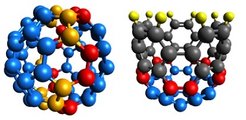Mülheim researchers detect fullerenes in low-energy materials - crude oil contains both buckyballs and buckybowls

Fullerenes are hollow closed molecules with high symmetry, consisting of carbon atoms. The best-known fullerene C60 has a structure reminiscent of a football. The name Fullerene - or Buckyball - goes back to the American architect Richard Buckminster Fuller, who designed geodesic domes whose symmetrical structure is similar to the one of these special molecules.
Although fullerenes were first reported more than 30 years ago, little is known about their natural occurrence. Until now, they have mostly been found at sites of high‐energy incidents, such as lightning strikes or meteor impacts - but not in low-energy materials such as fossil fuels.
A team from the Department of Mass Spectrometry at the MPI für Kohlenforschung has now been able to detect a broad spectrum of fullerenes from C30 to C114 in the asphaltene fraction of a heavy crude oil using ultra-high resolution mass spectrometry. The analyses showed the fullerenes in this heaviest part of the crude oil together with their building blocks of the C10nH10 stoichiometry. Quantum chemical calculations of the Department of Molecular Theory and Spectroscopy confirm their stability as spherical and hemispherical species. Interestingly, the maximum intensity of fullerenes was found at C40 instead of the major fullerene C60. Thus, the experiments supported by high‐level DLPNO‐CCSD(T) calculations prove not only the existence of buckyballs but also of buckybowls as 3-dimensional polyaromatic compounds in fossil materials.
The researchers from the groups of Professor Wolfgang Schrader and Professor Alexander Auer published their interesting research results in the article "Studying Natural Buckyballs and Buckybowls in Fossil Materials" on May 19, 2020 in the Angewandte Chemie https://www.onlinelibrary.wiley.com/doi/10.1002/anie.202005449



